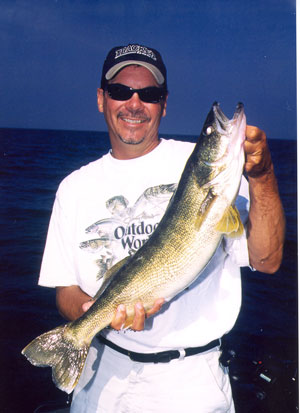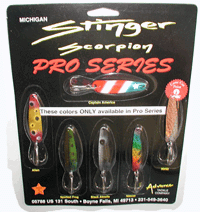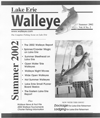|

Scorpion Stinger Spoons

Lake Erie Fishing
Maps

The Official Walleye.com
Lake Erie Walleye
Fishing Hat
|
Playing the “Weighting Game” Part 2 – Open Water
Trolling
By Keith Kavajecz & Gary Parsons
Having already covered such "walleye
weighting systems" as jigs, rigs and bouncers in our last article, we're now ready to switch gears and cover the "Weighting
Game" from a trolling standpoint. Over the past few years trolling has
become "The" tactic on many large bodies of water frequented by walleye
anglers... The Great Lakes, the Missouri River Reservoirs, Wisconsin's Lake
Winnebago and even Minnesota's Lake Mille Lacs are all becoming trolling
hot beds. More and more anglers are discovering that big lakes can most
effectively and efficiently be fished by tactics that cover a lot of water
and cover it quickly. But it's not as simple as using planner boards to
spread trolling lines horizontally to find fish... You've got to master the
vertical presentations also! That's where weighting systems come in to
play.
our last article, we're now ready to switch gears and cover the "Weighting
Game" from a trolling standpoint. Over the past few years trolling has
become "The" tactic on many large bodies of water frequented by walleye
anglers... The Great Lakes, the Missouri River Reservoirs, Wisconsin's Lake
Winnebago and even Minnesota's Lake Mille Lacs are all becoming trolling
hot beds. More and more anglers are discovering that big lakes can most
effectively and efficiently be fished by tactics that cover a lot of water
and cover it quickly. But it's not as simple as using planner boards to
spread trolling lines horizontally to find fish... You've got to master the
vertical presentations also! That's where weighting systems come in to
play.
Maybe to better illustrate our point, let's
look at one scenario and the different possible weighting systems that could
be used to get the job done. Let's say for instance that it's a beautiful
summer morning on Lake Huron's Saginaw Bay. The forecast is calling for
sunny skies and moderate breezes in the 10 to 15 mph range. As we head out
toward the Charity Islands, we know we're going to be dealing with suspended
walleyes so we begin by cruising our first area closely watching the fish
finder for signs of life. We don't go far and begin to see clouds of bait
fish near the surface, over 48 feet of water... things are beginning to look
good. We go a little further and see the tell-tale arcs of predator fish...
some down within two or three feet of the bottom, some about half way down
in the water column at about twenty five feet. These are the fish we're
looking to target. The higher fish are the active feeders and the ones
that are most likely going to bite.
Our weapons of choice on this day will be
spinners tipped with crawlers. On its own, a spinner won't go down in the
water very far at all on a troll, so we know we need a weighting system to
get the lure to the fish. We'll start off with two different weights ... Off
Shore Tackle Snap Weights and Bass Pro Shops XPS Keel Weights.
The Off Shore Tackle Snap Weights are lead
weights (available in various sizes) attached to an Off Shore Tackle model
OR-16 Snap Clip (Off Shore's popular "Red" clip). The weight can be clipped
to the main line anywhere from a few feet ahead of the lure to a hundred or
even a hundred and fifty feet ahead of the lure under extreme conditions
(extremely clear water - extremely spooky fish). When a fish is hooked, the
Snap Weight is simply removed from the line as the fish is being reeled in.
On this day we're dealing with fairly clear water, but the fish should be
aggressive enough not to be too spooky so we let out the spinner about fifty
feet before attaching a two ounce Snap Weight. Then we let out another fifty
feet and attach an Off Shore Tackle OR-12 Side Planer board to take the
presentation out to the side of the boat, spreading our baits to cover more
water. With an average trolling speed of 1 to 1.5 mph, our first spinner
should be right in that twenty two to twenty five foot range where we marked
the arcs earlier.
On another rod, let's rig one of the new
HOT XPS Keel Weights. These are "in-line" weights, meaning they are tied
into the line between the lure and the rod. The XPS Keel Weights act as not
only a weighting system, but also double as ATTRACTORS. The weights
are shaped like baitfish and feature holographic finishes that really elicit
a bright flashing effect in the water. On the main line we use a
ball-bearing snap-swivel to connect a one ounce XPS Keel Weight in the
Rainbow Trout finish, and then connect our spinner to the back of the weight
(also using a swivel). The spinner is tied on a four foot leader, which is
about an average length for use with in-line weights. If the weight was tied
much further from the spinner, it would make netting fish a tricky
proposition since the in-line weight obviously can not be easily removed as
in the case of the Snap Weight. Again we let out fifty feet of line before
hitching up an OR-12 Side Planer and send this set-up out into our trolling
pattern. By letting out a couple more lines varying the size of the weights,
we're soon trolling the area and covering a wide swath of the water column
both horizontally (with the use of the OR-12 Side Planer boards) and
vertically (various weights covering various depths).
So why the two different styles of weights?
They both serve basically the same function... that is take our offerings
down to the fish zone... but they each add their own attraction to the baits
and until we start getting bit, we won't know which one the walleyes prefer
on this given day. Snap weights, besides having the advantage of being able
to be attached virtually anywhere on the line, give baits like spinners a
much different action than in-line weights. Picture the scenario above... we
mentioned we were trolling in a moderate breeze, which we'll say had us
trolling in two to three foot waves. With the Snap Weight attached about
fifty feet ahead of a spinner, the rise and fall of the weight caused by the
board bobbing up and down in the waves, would induce only a slight
undulation in the trailing spinner because most of the bobbing action would
be lost in the fifty foot leader. On the other hand, with the Keel Weight
only four feet ahead of the spinner, as the board above climbs up and down
the waves, the weight rises and falls trailing the spinner close behind.
Which is better? Some days one ... some days the other ... that's one of
those things you need to let the walleyes tell you.
One other
weighting system used by walleye anglers in trolling scenarios is lead core
line. Volumes could be written about the use of lead core because the more
this system is used it seems the more versatile anglers are discovering it
can be. For that reason we'll save discussion on lead core for another day.
The main point to remember this season is to learn and understand all the
weighting systems available to you as a walleye angler. Learn the best times
to go "light weight" and when to go "heavy weight", when to troll Snap
Weights and when in lines or lead core would be better options. Learn the
ins and outs (or should we say ups and downs) of the Weighting Game and
you'll be on top of the "Walleye Game" all season long. |





 our last article, we're now ready to switch gears and cover the "Weighting
Game" from a trolling standpoint. Over the past few years trolling has
become "The" tactic on many large bodies of water frequented by walleye
anglers... The Great Lakes, the Missouri River Reservoirs, Wisconsin's Lake
Winnebago and even Minnesota's Lake Mille Lacs are all becoming trolling
hot beds. More and more anglers are discovering that big lakes can most
effectively and efficiently be fished by tactics that cover a lot of water
and cover it quickly. But it's not as simple as using planner boards to
spread trolling lines horizontally to find fish... You've got to master the
vertical presentations also! That's where weighting systems come in to
play.
our last article, we're now ready to switch gears and cover the "Weighting
Game" from a trolling standpoint. Over the past few years trolling has
become "The" tactic on many large bodies of water frequented by walleye
anglers... The Great Lakes, the Missouri River Reservoirs, Wisconsin's Lake
Winnebago and even Minnesota's Lake Mille Lacs are all becoming trolling
hot beds. More and more anglers are discovering that big lakes can most
effectively and efficiently be fished by tactics that cover a lot of water
and cover it quickly. But it's not as simple as using planner boards to
spread trolling lines horizontally to find fish... You've got to master the
vertical presentations also! That's where weighting systems come in to
play.